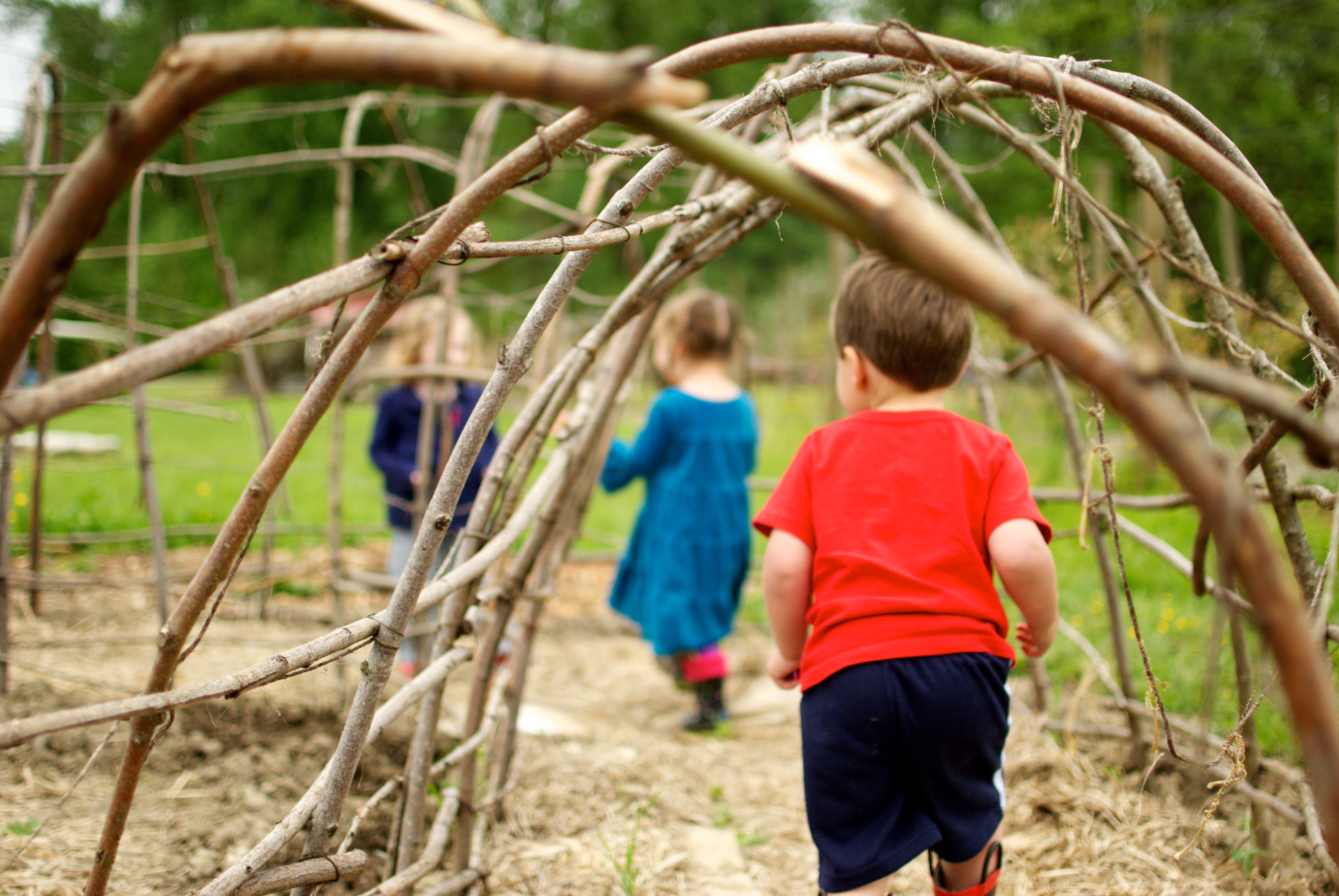
With her tiny, muscular frame, effusive smile and cropped white-blond curls, Sarah Cassidy commands attention. Even more striking is her booming, husky voice and infectious laugh that inevitably draws smiles from all in her presence — especially the multitudes of kids who tour Oxbow Farm, the 25-acre certified organic farm where Cassidy serves as education manager.
Visitors to Oxbow will most likely hear Cassidy's voice guiding a scavenger hunt, or perhaps telling preschoolers about the wonders of purple broccoli. But watch what you say. Cassidy has strong feelings about our current drought and its effect on local farms. She describes a dicey interaction at a recent farm-to-table dinner when a fellow attendee remarked about how much she loved the relentless sunny weather. “We almost came to blows,” Cassidy says, laughing. “I was like, how about your food? Do you like that?”
Cassidy works passionately to protect the environment. “I feel like I’m an environmentalist first,” she says, “and from that comes farming.”
That statement could also sum up what's distinctive about Oxbow, which enjoys a nonprofit status that sets it apart from many commercial farms. Landowners Tom and Judi Alberg have long been focused on promoting environmental stewardship, healthy food and education. With this focus, Oxbow looks different from many other farms that offer fall activities. In addition to staples such as a "House o' Hay" and a pumpkin slingshot, Oxbow also boasts a living playground (bean teepees, domes and tunnels), a kids' farm (complete with signs that test your veggie knowledge), a beautifully restored wetland and a native plant nursery. And while you can pick your a lovely jack-o'-lantern pumpkin, you can also find heirloom squash, homegrown popcorn and more beautiful and edible crops.

When Cassidy and her husband, Luke Woodward, were hired to begin farming Oxbow in 1999, they quickly began working with restoration groups to conserve and restore habitat in their area along the Snoqualmie River. They rigorously monitor the health of the oxbow — a horseshoe-shaped lake — that gives the farm its name, and provides a critical irrigation source.
Alongside other members of the growing Oxbow team, they have worked to restore a wetland to provide habitat for birds and amphibians, including planting native trees and shrubs that provide shade for waterways, protect salmon and other waterborne creatures and act as a water filtration system.

After having a daughter, Pearl, In 2006, Cassidy took a few years off from her work at Oxbow. In 2009, when Oxbow transitioned to become a nonprofit, Sarah returned to manage the educational programs. She was charged with getting kids to the farm. Now, through its field trips, camps and classes, thousands of children from around our region are familiar with this fabulous example of environmental sustainability on a working organic farm.
What's life like as an organic farmer, tirelessly dynamic educator and parent? Cassidy took time from her busy fall schedule to tell us.
How did your farming experience change when you became a mom?
Oh my goodness! Basically I had to stop farming when I became a mom. Before Pearl, I thought the farm was my baby and I treated it as such. I quickly realized that having two babies, one that never grew up, would be impossible. I was really able to slow down with Pearl and learn about the magic of her perspective on things. I loved seeing the natural world from that end so when I came back to Oxbow as the education manager, it gave me a different and fresh perspective of the child’s experience of that world.
How has farming shaped Pearl’s life?
Pearl grew up on the farm. She would just kind of meander around, along with the kids of other families who worked at Oxbow. If we don’t have childcare, the kids just come with us. They learn which fields to go into and which ones to avoid. They learn about growing things. They watch seasons passing through. Blossoms become fruit. Sunflowers become seeds. Pearl likes to have her own section of soil to plant seeds.

Does she want to follow in your footsteps?
(Laughing) I think we may be skipping a generation with Pearl. She needs to support her parents’ farming habit.
Can you describe your typical fall day at Oxbow?
Well, right now we are hosting loads of school groups at the Kids’ Farm from morning to early afternoon — flocks of free-range kids wander through the fields and graze on carrots, gallop through the sunflowers, and nibble seeds and fruits and leaves. Lots of little ones, but also junior high and high schoolers, who are curious about food politics and how food is grown.
Afternoons are devoted to the harvest! I go out to the fields with our three wonderful interns and help identify what needs to come in (right now lots of popcorn ears, gourds, beans, sunflower seeds, and squash). With this freakishly warm weather, we are still getting good yields of tomatoes and sweet peppers too! Then I peel off to go take Pearl to karate, where I work via phone.
Right now we have lots going on because our excellent Executive Director, Jessica Price, just won us a Farm to School grant. I also work with Oxbow’s wonderful Education Coordinator Meredith Rivlin on registration for our new programs and field trip issues — like “Yikes! The school bus is stuck in the mud!” — and all the other challenges of hosting thousands of kids on a working farm! Always something to do here. Until December, at least… then, we let the rains come! And order seed, and plan the crop rotations and summer camp logistics, and get ready for our “Farmer In the Class” programs that start up in January.
What does a field trip look like?
Today a group of fourth, fifth and sixth graders were here learning about our restoration efforts. One of their activities involved finding and identifying beneficial insects.
For little ones, we center farm adventures around a six-part scavenger hunt. They run around looking for roots, stems, leaves, flowers, fruits and seeds — finding these things and eating them. It’s great for kids who think their food comes from the shelf in the grocery store.
What should families think about when picking their fall pumpkins?
This is the organic farmer's lament! I mean, it’s ironic that we grow so many pounds of pumpkins and they’re not so edible. Still, because everything we grow is organic, our not-so-edible pumpkins are still good for the soil and the inhabitants of the watershed, so there’s that. Anyway, we choose our pumpkins based on a few different criteria. We grow your typical jack-o’-lantern pumpkin because that is what a lot of people want, but it’s not the best for eating. So we like to grow a lot of heirlooms and squash that work for decorating, but are also good to eat.
Sustainably-minded families could consider a beautiful heirloom pumpkin. We grow romantic Cinderella and dramatic slate-blue Jarrahdale pumpkins which are both beautiful and also good eating.
What else might families consider decorating with, besides pumpkins?
Popcorn! We grow a lot of popcorn on the kids’ farm and we sell it at our farm stand. It is both beautiful and edible. Calico and Dakota Black are two of my favorites. Both are gorgeously ornamental! After you use it as holiday decoration, it is perfectly dried to use as popcorn. After Thanksgiving is the perfect time — six to eight weeks from the field. Just remove it from the cob, pop and eat.
We also grow a lot of beautiful fun gourds. Tiny gourds that can be spun like tops — not edible, but fun to play with.
 If you go ... fall programs at Oxbow Farm
If you go ... fall programs at Oxbow Farm
When: The public is invited to Oxbow every Thursday–Sunday from 10 a.m.–5 p.m. throughout October.
Where: 10819 Carnation Duvall Road N.E., Carnation. Oxbow is using its west entrance during pumpkin season. Follow these directions (Google Maps and iPhone maps don't guide correctly.)
Activities: U-pick pumpkins, farm stand, Kids' Farm (3 Sisters Path, Guess the Veg signs); Living Playground, climbing tractor, House o’ Hay (a castle built from straw bales, aka rainy-day playhouse with indoor picnic tables, and enough nooks and crannies to keep kids happy for hours); Pumpkin Sling King (pumpkin sling-shot); indoor and outdoor picnicking areas; scavenger hunts.
Birthdays: The Kids’ Farm greenhouse is available for rental by groups for birthday parties and other private gatherings, with add-ons such as a hay ride, and more.
CSA: One of the best ways to connect with Oxbow (or other local, organic farms) is to subscribe to a community-supported agriculture box of produce through the growing season, typically from June to November. Check back here for next year.
Recipes: Oxbow has a number of veggie-focused recipes on its website, including a pumpkin pie recipe it shares with field-trip kids in the fall.
Information: Get all the information on fall fun at oxbow.org/pumpkins.











